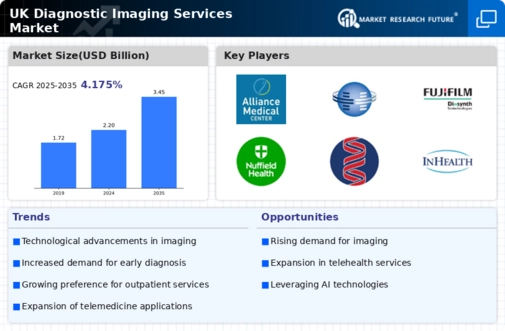Aging Population
The demographic shift towards an aging population in the UK significantly influences the diagnostic imaging services market. As individuals age, the likelihood of developing health issues increases, leading to a higher demand for diagnostic imaging. The Office for National Statistics indicates that by 2030, the number of people aged 65 and over is projected to rise by 20%, which will likely escalate the need for imaging services. Older adults often require regular screenings and diagnostic evaluations, thereby driving the market's growth. Healthcare facilities are thus compelled to enhance their imaging capabilities to cater to this demographic, ensuring timely and accurate diagnoses.
Increased Healthcare Expenditure
The rise in healthcare expenditure in the UK is a crucial driver for the diagnostic imaging-services market. Government initiatives aimed at improving healthcare infrastructure and access to advanced medical technologies have led to increased funding for diagnostic services. In recent years, the UK government has allocated significant resources to enhance healthcare facilities, which includes upgrading imaging equipment. This financial commitment is likely to boost the diagnostic imaging-services market, as healthcare providers are better equipped to offer comprehensive imaging services. Enhanced funding also facilitates research and development, further driving innovation within the market.
Growing Awareness of Early Diagnosis
There is a growing awareness among the UK population regarding the importance of early diagnosis in managing health conditions, which serves as a significant driver for the diagnostic imaging-services market. Public health campaigns and educational initiatives have emphasized the benefits of early detection, leading to increased patient engagement in preventive healthcare. As individuals become more proactive about their health, the demand for diagnostic imaging services is expected to rise. This trend encourages healthcare providers to expand their imaging offerings, ensuring that patients have access to necessary diagnostic tools for timely intervention.
Rising Incidence of Chronic Diseases
The increasing prevalence of chronic diseases in the UK is a primary driver for the diagnostic imaging-services market. Conditions such as cardiovascular diseases, diabetes, and cancer necessitate advanced imaging techniques for accurate diagnosis and monitoring. According to recent statistics, chronic diseases account for approximately 70% of all deaths in the UK, highlighting the urgent need for effective diagnostic tools. This trend is likely to propel the demand for imaging services, as healthcare providers seek to enhance patient outcomes through early detection and intervention. The diagnostic imaging-services market is expected to expand as hospitals and clinics invest in state-of-the-art imaging technologies to meet the growing healthcare demands.
Integration of Artificial Intelligence
The integration of artificial intelligence (AI) in the diagnostic imaging-services market is transforming the landscape of medical diagnostics in the UK. AI technologies enhance image analysis, improve diagnostic accuracy, and streamline workflows, which can lead to reduced operational costs. Recent studies suggest that AI can increase diagnostic accuracy by up to 30%, making it a valuable asset in clinical settings. As healthcare providers increasingly adopt AI-driven solutions, the demand for advanced imaging services is expected to rise. This technological evolution not only improves patient care but also positions the diagnostic imaging-services market for substantial growth in the coming years.


















Leave a Comment